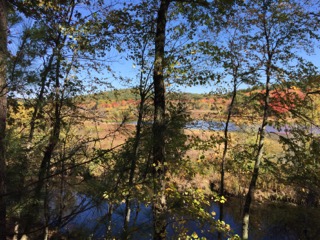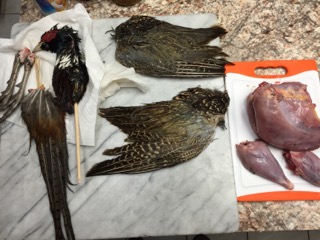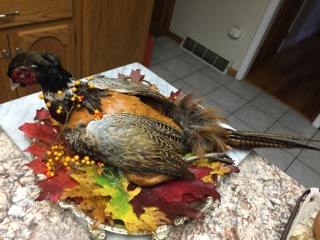Bagging a Pheasant for Class
by Keith Duhamel
Student Keith Duhamel shares his experience in hunting and preparing a pheasant, 16th century style, for the Food History course as part of the MLA in Gastronomy core curriculum.
 Autumn in New England evokes images of trees ablaze. Reds, oranges and yellows seem to light the horizon against a clear blue sky; crisp cool air in the morning balanced with warm gentle breezes as the day progresses; heading to the apple orchard, though the orchards of yesteryear are replaced today with neat ,orderly rows, manicured and pristine, like soldiers awaiting inspection; and heading to the pumpkin patch for that perfect orange sphere to carve out your jack-o-lantern.
Autumn in New England evokes images of trees ablaze. Reds, oranges and yellows seem to light the horizon against a clear blue sky; crisp cool air in the morning balanced with warm gentle breezes as the day progresses; heading to the apple orchard, though the orchards of yesteryear are replaced today with neat ,orderly rows, manicured and pristine, like soldiers awaiting inspection; and heading to the pumpkin patch for that perfect orange sphere to carve out your jack-o-lantern.
Autumn also means, to many a native New Englander, the start of hunting season. For me, donning the orange (so that I’m recognizable to other hunters) and loading the century old double barrel shotgun once used by my grandmother on her honeymoon (no, not that type of shotgun wedding) means the hope of getting a pheasant or two.
 This year, in particular, hunting season coincided with our Food History class studying the medieval period, and my desire to “bag” a pheasant was only magnified. Dr. Ken Albala’s class has taken us on a journey through time and this period in food evolution intrigued me the most thus far. The ostentatious displays of food by the wealthy of the late 15th and early 16th century certainly lend one to imagine dishes in excess.
This year, in particular, hunting season coincided with our Food History class studying the medieval period, and my desire to “bag” a pheasant was only magnified. Dr. Ken Albala’s class has taken us on a journey through time and this period in food evolution intrigued me the most thus far. The ostentatious displays of food by the wealthy of the late 15th and early 16th century certainly lend one to imagine dishes in excess.
My first endeavor out into the fields, however, resulted in nil, unless we count the ticks. Luckily, on my second trip I bagged me-self a beautiful rooster, the name for a male pheasant. The iridescent coloring of his plumage sparkled in the sunshine, and I knew this guy would make a meal fit for the King.
 In respect of the period, preparation and accompaniments were lavish. After dismemberment, the breast was roasted briefly over a wood fire. As this was occurring, I prepared a stuffing of short grain rice seasoned with dates, homemade almond milk, cinnamon, ginger, garlic and a splash of verjus. I stuffed the breast, wrapped it in bacon and swaddled the entirety in a simple pastry of flour and water. Once baked, the head, wings, tail and feet were re-attached, if you will, and served on a bed of autumn leaves and a sprig of bittersweet (a modern touch).
In respect of the period, preparation and accompaniments were lavish. After dismemberment, the breast was roasted briefly over a wood fire. As this was occurring, I prepared a stuffing of short grain rice seasoned with dates, homemade almond milk, cinnamon, ginger, garlic and a splash of verjus. I stuffed the breast, wrapped it in bacon and swaddled the entirety in a simple pastry of flour and water. Once baked, the head, wings, tail and feet were re-attached, if you will, and served on a bed of autumn leaves and a sprig of bittersweet (a modern touch).
My guests that night were indulged in a meal that was nothing short of spectacular, if I do say so myself. In true fashion of Medieval times, and at the recommendation of Dr. Albala, I stuffed his beak with a cotton ball soaked in alcohol and lit him ablaze. Autumn’s breath of fire collided in all aspects of this dish. Phineas, as we named him, was succulent and moist, tasting of smoky bacon balanced with the spiced sweetness of the stuffing. Autumn is a time of preparation, a time to reflect and prepare for the winter ahead. Phineas graciously gave of himself, so that I, and my guests may do just that.
Dr. Ken Albala will be teaching the Food History class again for the Spring 2015 semester.
Cover photo credit: innyangling.net